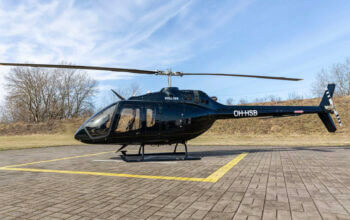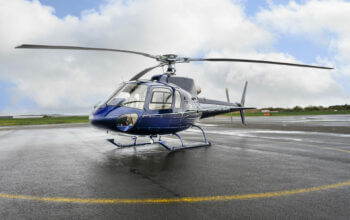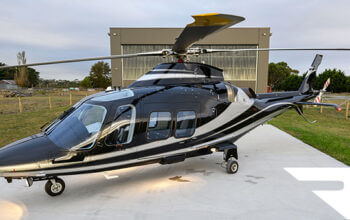Estimated reading time 18 minutes, 30 seconds.
In retrospect, the decision to launch the Challenger 300 seems bold. In 1999, when Bombardier unveiled the new design at the Paris Air Show, the company already enjoyed considerable commercial success with both its Challenger and Learjet lines. Nevertheless, success in the business jet arena demands a thorough knowledge of one’s customers. Bombardier wagered that a market segment existed between their two lines for a jet that could carry eight passengers at 0.80 Mach with continental range. In fact, the new design was originally named the Continental, although Bombardier was quick to notice that the name would short-change some of its impressive capability.
Market demand for the new Challenger 300 was emphasized in 2012 when international fractional ownership and charter giant, NetJets, placed a stunning US $7.3 billion order with Bombardier. The purchase included a firm order for 75 Challenger 300s, with options for a further 125. (It also included a firm order for 25 Challenger 605s, with options for another 50.) This effectively put NetJets in competition with Bombardier’s wholly-owned subsidiary, Flexjet, which also operates a fleet that includes the Challenger 300. This vote of confidence from the fractional ownership and charter world, where aircraft work hard for a living on diverse missions, must surely gratify Bombardier.
It was my pleasant task to visit the Bombardier Service Center in Hartford, Conn., to evaluate the Challenger 300 and to find out why this jet was getting so much attention. My tour guide was Bombardier demonstration pilot Owen Zahnle. During his thorough hands-on briefing, Zahnle explained that Bombardier started the Challenger 300 design with a clean sheet of paper, intent upon meeting performance goals with a design that was as simple as possible. Highlights include the all-DC electrical system, and simplified dual hydraulic system design. The flight controls are mechanically actuated, with hydraulic boost on the elevators and rudder. Roll control is provided by a combination of ailerons and two multifunction spoiler panels per side. The multifunction aspect of the spoilers is that they also serve as continuously variable speed brakes.
The inboard wings have generous ground spoilers which can automatically deploy on landing. The large flaps and powerful carbon brakes provide impressive field performance. The jet is powered by the Honeywell HTF7000 engine, a full authority digitally controlled (FADEC) powerplant rated at 6,826 pounds thrust to ISA + 15ºC. Bombardier claims a sea level takeoff field length of 4,810 feet, under standard atmospheric conditions (ISA).
It’s a struggle to describe the cabin of a modern business jet; an almost surreal environment where every conceivable comfort and amenity is carefully engineered. The cabin of this super midsize jet struck me as tastefully opulent. With a generous list of standard equipment, Bombardier advised that about 80 per cent of aircraft are delivered in the same configuration, featuring a spacious double club seating arrangement; a three-seat divan is optional. Passengers will appreciate the 1.85 metre (six foot, one inch) headroom from the flat floor, unrestricted cabin access to baggage, and the state-of-the-art entertainment system. A neat piece of technology is the audio system, which incorporates 12 sound transducers built into each of the cabin side panels. Fire it up, and high-fidelity sound seems to come from everywhere.
Following our tour of the cabin, Zahnle walked me forward and gestured for me to take the left seat. I settled in, took a look around, and just grinned. Bombardier got the Challenger 300 cockpit absolutely right! The layout was simple, consistent and conventional. I’m appreciative of how Bombardier mechanized the FADEC with good old fashioned moving throttles. The seat adjusted easily, and should accommodate almost every creature in the pilot gene pool. Storage was plentiful. The field of view was adequate through the Learjet-style tapered cockpit windows. Rockwell Collins’ Pro Line 21 avionics suite dominated the instrument panel with four bright 10×12-inch liquid crystal displays. The autopilot mode selector panel was placed, airliner style, in the central glareshield subpanel, and was well laid out. The outboard edges of the subpanel placed controls for the left and right primary flight displays (PFD) directly in front of each pilot. Controls for the multi-function displays (MFDs) were on the centre console, directly beneath the flight management system (FMS) keyboards. Everything seemed to fall to hand conveniently-, and within minutes it was all familiar enough that I felt ready to grab the checklist and get started. I particularly appreciated the layout of the systems control panels on the centre console, how the switch patterns formed a virtual schematic of the various systems, and how the patterns conformed with the presentation on the systems synoptic pages on the MFD. Everything fit onto the panel, with no requirement for controls to spill into the overhead area.
Our flight would be in N305CL, the 305th Challenger 300 off the production line. It had a basic operating weight (BOW) of 24,664 pounds, including two 190-pound crewmembers. With a scant 5,950 pounds of fuel (out of a maximum capacity of 14,150 pounds), and one passenger, the ramp weight was 30,794 pounds, which was well under the maximum takeoff weight of 38,850 pounds.
I started up the engines while Zahnle ran the checklist, and in short order we were ready to taxi. Idle thrust was pleasantly low, requiring a hint of throttle to start rolling, confirming that there would be no need to ride the brakes while taxiing. Ground handling was light and responsive. The brakes and tiller-controlled nosewheel steering were electronic, but incorporated artificial feel. The brakes in particular required some adaptation. Deceleration was proportional to displacement, not pedal pressure, creating a few jerky moments before I recalibrated myself, after which it became pleasant.
Normal takeoffs are performed with the auxiliary power unit (APU) running, as reducing the burden of drawing pressurization bleed air from the engines provides the capacity to lift an additional 250 pounds from an equivalent field length. Our planned 10 degree flap, static thrust takeoff was simple, befitting a FADEC jet. We lined up on Hartford’s Runway 33-Left, held the brakes, pushed the thrust levers forward to the takeoff detent, and after about five seconds of engine spool-up, we were ready to roll. Initial acceleration at our light weight was very satisfying. Centreline tracking was precise and almost effortless. Upon rotation, about a 20-pound pull was sufficient to capture the flight director bars and commence a climb. Landing gear and flap retraction were quiet and smooth.
I engaged the autopilot, and Zahnle recommended climbing in vertical speed (VS) mode, confessing that the autopilot chased airspeed slightly in the more usual flight level change (FLC) mode. Boston Center assigned us intermediate level-offs during the climb, but I can report that the published climb schedule of 250 knots indicated airspeed (KIAS) to 0.75 Mach produced 4,000 feet per minute climb rate passing through 14,000 feet (ISA + 10ºC). Passing flight level (FL) 250, or 25,000 feet, we had transitioned to a cruise climb of 300 KIAS and were still indicating 2,000 feet per minute. The Challenger 300 is a strong climber by any standards. Admittedly we were light, but the flight manual confirms that at maximum takeoff weight, the Challenger 300 can climb directly to FL430 (43,000 feet) at ISA conditions.
We leveled at FL410 (41,000 feet). Under ISA-3ºC conditions, I captured 0.80 Mach, or 453 knots true airspeed (KTAS), burning 1,690 pounds per hour, which compares closely with the published numbers. The FMS obligingly displayed our weight as 29,230 pounds. The FADEC matched the engine parameters perfectly.
Zahnle was keen to demonstrate cruise at the maximum operating Mach (MMO) of 0.83 Mach. Fuel flow rose to 1,810 pounds per hour in exchange for a 471 KTAS cruise speed. Under conditions of light chop, I assessed the autopilot Mach hold function. Fuel flows varied by ±40 pounds per hour, but the speed stayed precisely at 0.83 Mach. Lacking autothrottles, Zahnle described Mach hold as a limited authority cruise control, within a ±3 per cent engine speed (N1) authority.
Air traffic control (ATC) gave us some room to maneuver, and I disconnected the autopilot to do some actual flying. Pilots will rarely hand-fly the Challenger 300 at cruise altitude, so they will have to take my word that it’s a very pleasant experience. I started with gentle bank-to-bank roll reversals, just to get the feel of the roll response. The small ailerons, augmented by multi-function spoilers, provided generous and crisp roll response. I did a fixed-power level turn to 45º bank at FL410, starting at 0.8 Mach. There was not a hint of buffet. The flight controls were light and precise, and I was surprised that I only needed about 20 pounds of back pressure on the yoke.
Once cleared to descend by ATC, I trimmed off the jet, released the yoke, and yanked open the flight spoilers. The result was a soft transition to descent and deceleration. The flight spoilers required a push button on top of the lever to unlock, then were continuously variable. A detent at the end of the travel was marked EMER, which would open one of the ground spoiler panels. Its use was restricted to actual emergencies, as prescribed in the checklist.
We levelled off briefly at 15,000 feet, and Zahnle let me simulate an engine failure and overshoot. Configured for landing at our approach speed (VREF) of 113 KIAS, I pulled the left engine to idle and applied takeoff power on the right. At our operating weight of 28,600 pounds, it was a non-event. There was plenty of rudder control power, and with a hydraulically boosted rudder, the pedal force didn’t exceed about 40 pounds. Even at 15,000 feet, it seemed a strong climber on one engine.
All too soon, Bombardier wanted their jet back, and we were cleared for an instrument approach (ILS) to Hartford’s Runway 24. I hand flew the ILS, and proceeded to further acquaint myself with the jet. I slowed to 180 KIAS to look at configuration change dynamics. Selection of FL10 took almost 10 seconds, and was almost completely transparent, with negligible trim change. Undercarriage extension resulted in some faint clunks, but was mainly evident from the three green lights on the EICAS (engine-indicating and crew-alerting system) display. At our landing weight of 27,800 pounds the FMS displayed a factored landing distance of 3,842 feet (inclusive of a 15 per cent margin). From takeoff to touchdown, the Challenger 300 delivered impressive utility and performance, and seemed to be trying to make me look good in the process.
Walking away from the test flight, I recall feeling more enthusiastic about the Challenger 300 than I thought seemly for an objective evaluator. In search of a more balanced appraisal of the jet, I called Dale Hackett, chief pilot for Irving Oil Transport. They operate two Challenger 300s from their base in Saint John, N.B. If my plan was to temper my enthusiasm, Hackett was absolutely no help.
It does everything they advertise, he offered. We couldn’t ask for a more perfect airplane for our needs. Irving Oil replaced their Hawker 800XP and Falcon 50 EX with the two Challenger 300s in June 2009. Their diverse corporate missions emphasize the aircraft’s capabilities. In addition to flights around North America, they travel to destinations in Western Europe four to six times per year, and typically make it back to their Saint John base non-stop against North Atlantic winds; capability that may explain why Bombardier was reluctant to name the jet a Continental. Highlighting its flexibility, Irving Oil’s jets also regularly access 4,000 foot runways in northern New Brunswick.
Hackett relates that his passengers love the interior layout, the stand-up cabin and the in-flight access to baggage. Their aircraft has the optional divan that configures into a berth for long flights.
Hackett also gave high marks to Bombardier’s support. He had nothing but praise for their customer support representative, Howard Dransfield. Hackett related with enthusiasm how during his quarterly visits, Dransfield regularly takes off his jacket and tie, and gets his hands dirty on the hangar floor with the maintenance staff. Outstanding, was how he described their working relationship with Bombardier.
Following a recent FMS software update, Hackett foresees no need to upgrade the aircraft. Pressed for something to complain about, he allowed that it would be nice to have a laser-inertial reference system (IRS) to back-up GPS for transatlantic navigation; an option not currently available.
The Challenger 300 is not a kitchen sink design with every feature and function. Bombardier seems cognizant of the difference between customer wants and needs, and has managed to deliver a cost-competitive midsize jet with impressive utility. The core mission of the Challenger 300 is to offer eight passengers a 0.8 Mach cruise at FL 410 with transcontinental range. After almost a decade in service, with 345 of the type currently in operation, it seems clear that Bombardier’s clean-sheet-of-paper Challenger 300 was indeed what customers were waiting for.
A graduate of the U.S. Naval Test Pilot School, Rob Erdos is an experimental test pilot licenced for fixed- and rotary-wing aircraft. In addition to being an engineering graduate from the Royal Military College, and holding a masters degree in aviation systems research, Rob is a former Canadian Air Force SAR pilot. An avid airplane builder, and a passionate flyer of historical aircraft for Vintage Wings of Canada, Rob flies such iconic planes as the Spitfire and Hurricane.
Notice a spelling mistake or typo?
Click on the button below to send an email to our team and we will get to it as soon as possible.
Report an error or typoHave a story idea you would like to suggest?
Click on the button below to send an email to our team and we will get to it as soon as possible.
Suggest a story
















